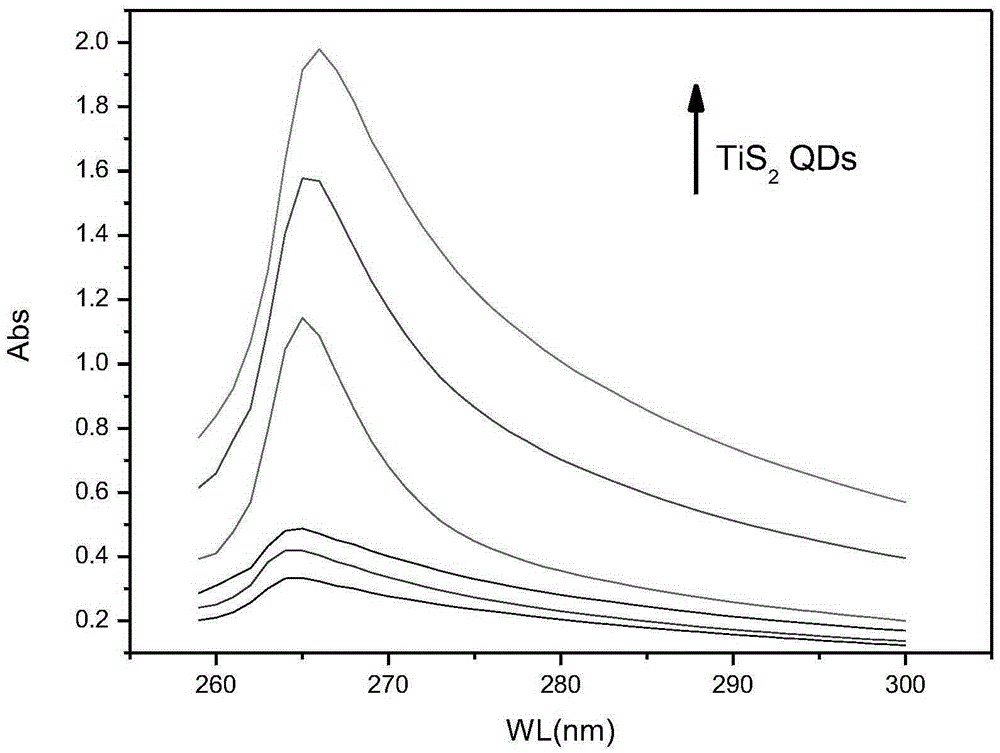Preparation method of titanium disulfide nanosheet/quantum dot composite mercury ion fluorescent probe
A titanium disulfide, fluorescent probe technology, applied in the intersection of chemistry, physics and materials science, to achieve the effect of high sensitivity, simple equipment and broad application prospects
- Summary
- Abstract
- Description
- Claims
- Application Information
AI Technical Summary
Problems solved by technology
Method used
Image
Examples
Embodiment 1
[0034] Weigh 20mgTiS 2 The powder was dispersed in 5mL N-methylpyrrolidone, and ultrasonically treated for 1h to form a suspension. Centrifuge the sonicated suspension and collect the upper dispersion to remove larger particles. Pour the upper dispersion liquid into the flask, and stir the reaction with magnetic force at 100°C for 6h to obtain TiS 2 QDs / nanosheet composite solution. The complex solution was centrifuged, and the upper dispersion was collected as TiS 2 QDs, the lower precipitate is TiS 2 Nanosheets. Add 0.1M phosphate buffer (pH=7.0) to the prepared upper layer dispersion, stir and react at room temperature for 15min, then add 10μLODN (20μM), incubate at room temperature for 12h, and then dialyze in a dialysis bag to remove unreacted TiS 2 QDs, prepared ODN surface-modified TiS 2 QDs. ODN surface modified TiS 2 QDs dispersion and TiS2 Nanosheet dispersion mixed, where TiS 2 QDs and TiS 2 The mass ratio of the nanosheets is 1:2, incubate at room temper...
Embodiment 2
[0037] Weigh 30mgTiS 2 The powder was dispersed in 5mL N-methylpyrrolidone, and ultrasonically treated for 2h to form a suspension. Centrifuge the sonicated suspension and collect the upper dispersion to remove larger particles. Pour the upper dispersion liquid into the flask, and stir the reaction with magnetic force at 120°C for 6h to obtain TiS 2 QDs / nanosheet composite solution. The complex solution was centrifuged, and the upper dispersion was collected as TiS 2 QDs, the lower precipitate is TiS 2 Nanosheets. Add 0.1M phosphate buffer (pH=8.0) to the prepared upper layer dispersion, stir and react at room temperature for 15min, then add 20μLODN (20μM), incubate at room temperature for 24h, and then dialyze in a dialysis bag to remove unreacted TiS 2 QDs, prepared ODN surface-modified TiS 2 QDs. ODN surface modified TiS 2 QDs dispersion and TiS 2 Nanosheet dispersion mixed, where TiS 2 QDs and TiS 2 The mass ratio of nanosheets is 1:5, incubate at room temperat...
Embodiment 3
[0040] Weigh 50mgTiS 2 The powder was dispersed in 5mL N-methylpyrrolidone, and treated with ultrasound for 5h to form a suspension. Centrifuge the sonicated suspension and collect the upper dispersion to remove larger particles. Pour the upper dispersion liquid into a flask, and react with magnetic stirring at 150°C for 6 hours to obtain TiS 2 QDs / nanosheet composite solution. The complex solution was centrifuged, and the upper dispersion was collected as TiS 2 QDs, the lower precipitate is TiS 2 Nanosheets. Add 0.1M phosphate buffer (pH=9.0) to the prepared upper layer dispersion, stir and react at room temperature for 15min, then add 50μLODN (50μM), incubate at room temperature for 36h, and then dialyze in a dialysis bag to remove unreacted TiS 2 QDs, prepared ODN surface-modified TiS 2 QDs. ODN surface modified TiS 2 QDs dispersion and TiS 2 Nanosheet dispersion mixed, where TiS 2 QDs and TiS 2 The mass ratio of nanosheets is 1:10, incubate at room temperature ...
PUM
 Login to View More
Login to View More Abstract
Description
Claims
Application Information
 Login to View More
Login to View More - R&D
- Intellectual Property
- Life Sciences
- Materials
- Tech Scout
- Unparalleled Data Quality
- Higher Quality Content
- 60% Fewer Hallucinations
Browse by: Latest US Patents, China's latest patents, Technical Efficacy Thesaurus, Application Domain, Technology Topic, Popular Technical Reports.
© 2025 PatSnap. All rights reserved.Legal|Privacy policy|Modern Slavery Act Transparency Statement|Sitemap|About US| Contact US: help@patsnap.com



